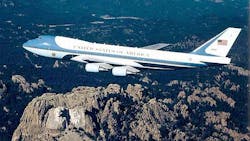Boeing undertakes major avionics upgrades to extend life spans of Air Force One aircraft
Officials of the Air Force Life Cycle Management Center at Tinker Air Force Base, Okla., announced a $9.3 million contract late last week to the Boeing Aerospace Operations segment in Oklahoma City, Okla., for the VC-25A Avionics Modernization Program (AMP).
The VC-25A air transport fleet consists of two specially configured Boeing 747-200B jumbo jets configured to transport the U.S. president to destinations around the world. The aircraft must maintain 100 percent reliability and safe, unrestricted global access to civil and military airfields.
The AMP upgrades involve enhanced pilot awareness by incorporating several subsystems to increase the utility and safety of the VC-25A. Installations are aligned with the aircraft heavy maintenance schedule.
The design service life of the VC-25A is about 30 years, with an average of about five years remaining. The AMP modifications are to help extend that jumbo jet's service life.
The VC-25 aircraft has cutting-edge navigation, electronic, and communications equipment that include multi-frequency radios for air-to-air, air-to-ground, and satellite communications. For self-defense, the VC-25 is equipped with advanced electronic countermeasures and anti-missile flares.
The aircraft has a presidential suite beneath the cockpit with stateroom, dressing room, lavatory, and shower, including an office for the president. The plane also has a conference and dining room, and accommodations for guests, senior staff, Secret Service, Air Force security personnel, and news media. The aircraft's two galleys can provide up to 100 meals at a time.
Air Force leaders say they expect start replacing the VC-25 fleet in 2019, most likely with the Boeing 747-8i. On this contract Boeing will do the work in Oklahoma City, Okla., and San Antonio, Texas, and should be finished by May 2018.
For more information contact Boeing online at www.boeing.com, or the Air Force Life Cycle Management Center at www.wpafb.af.mil.
About the Author
John Keller
Editor-in-Chief
John Keller is the Editor-in-Chief, Military & Aerospace Electronics Magazine--provides extensive coverage and analysis of enabling electronics and optoelectronic technologies in military, space and commercial aviation applications. John has been a member of the Military & Aerospace Electronics staff since 1989 and chief editor since 1995.
